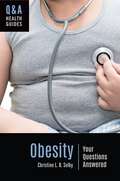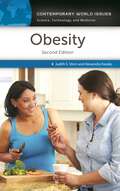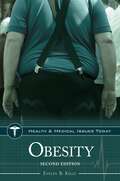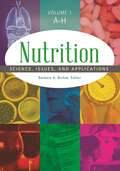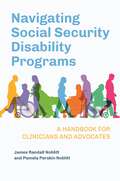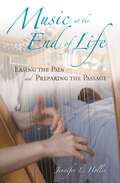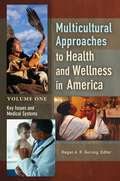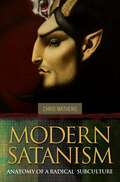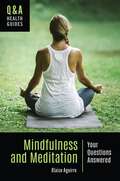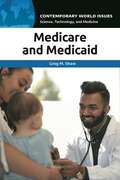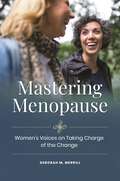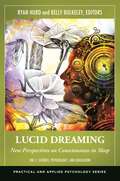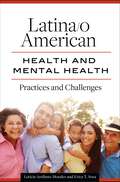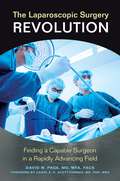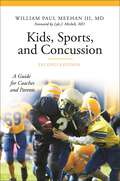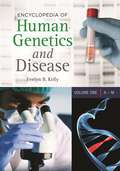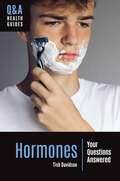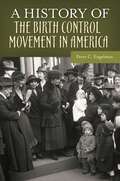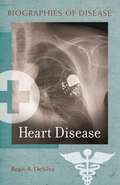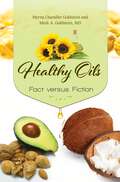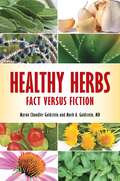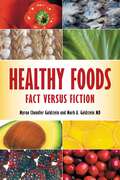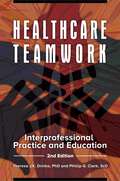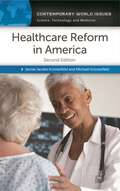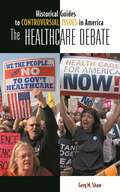- Table View
- List View
Obesity: Your Questions Answered (Q&A Health Guides)
by Christine L. SelbyThis book serves as an accessible resource for teens who want to learn more about obesity. The information and guidance it offers make it a valuable tool for young adult readers with questions or concerns about their weight.Obesity—represented by a BMI over 30—may be easy to define, but its causes and consequences and how individuals and agencies should address it are not as clear. Is obesity simply the result of eating more calories than one burns, or are other factors involved? Can an individual be obese and healthy? How does obesity affect psychological and social health? Are public health campaigns targeted at reducing obesity helping or hurting? Obesity: Your Questions Answered, a part of Greenwood's Q&A Health Guides series, answers these and other questions related to this high-interest topic. Each book in this series follows a reader-friendly question-and-answer format that anticipates readers' needs and concerns. Prevalent myths and misconceptions are identified and dispelled, and a collection of case studies illustrates key concepts and issues through relatable stories and insightful recommendations. The book also includes a section on health literacy, equipping teens and young adults with practical tools and strategies for finding, evaluating, and using credible sources of health information both on and off the internet—important skills that contribute to a lifetime of healthy decision-making.
Obesity: A Reference Handbook (Contemporary World Issues)
by Judith S. Stern Alexandra KazaksObesity has reached epidemic proportions in countries like the United States. This book provides a comprehensive summary of obesity in America and around the world, discussing the causes and proposing ways to help stem the tide and to help those who are overweight.A highly useful and accessible resource for high school to undergraduate students as well as post-graduate level readers with an interest in health and nutrition, this updated second edition of Obesity: A Reference Handbook offers up-to-date answers to essential questions about obesity and connected societal and health care-related issues. A single-volume, go-to resource, this book addresses difficult questions such as whether obesity is a disease or a moral failing; what factors contribute to obesity; what the economic impacts of obesity are on the health care industry; if and how poverty is a contributor to obesity; how our society encourages obesity; and how changes can be made to improve our society's eating habits as a whole. It presents citations from individuals and peer-reviewed journals and review articles, providing a balance of information sourced from both professionals and informed lay commentators. Also included are dozens of biographies of individuals who have been important in studying, preventing, managing, or increasing awareness about obesity, such as Jared Fogle, longtime Subway sandwiches spokesperson; Kelly Brownell, who coined the phrase "toxic environment" to describe unhealthy food and exercise patterns; researcher Ethan Allen Sims, who examined the relationship between obesity and diabetes; and Oprah Winfrey, well-known celebrity who stated that if there were a pill to lose weight or a magic diet, she would have it.
Obesity (Health and Medical Issues Today)
by Evelyn B. KellyThis book explores what obesity is, its causes and implications for health, and the many issues and controversies surrounding it, both in the medical community and within society as a whole.Obesity is defined as the state of having a body mass index (BMI) greater than 30. Although it may be easy to identify what obesity is, however, identifying its causes and effects can be more challenging. Genetic, hormonal, environmental, and behavioral factors all play a role in defining our weight, and the consequences of obesity go far beyond medical complications, to include impacts on psychological well-being and social health, and how we think about and address this growing epidemic has become just as controversial as it is important.This second edition of Obesity offers a wealth of new information and features. Coverage of genetic and hormonal causes of obesity has been greatly expanded, as has discussion of medications and surgical techniques to manage obesity. The book reflects our expanded scientific understanding of obesity and delves into medical and societal debates about weight that have emerged in recent years. Also new in this edition is a collection of case studies, each of which helps to make the topics discussed in the book more accessible to readers.
Nutrition [2 volumes]: Science, Issues, and Applications [2 volumes]
by Barbara A. Brehm, EditorThis thorough one-stop resource draws on solid science and the latest research to play a dual educational role—providing background for students while answering general readers' questions about a wide range of nutrition-related topics.Nutrition is a popular but often misunderstood topic, one about which there is a great deal of interest as evidenced by the plethora of available advice. Because nutrition is a key factor in health, it is important that the public have a source of information they can trust. This is that source: a comprehensive overview that will help readers make sense of conflicting information they find in the media regarding what is healthy and what is not. Organized alphabetically, the two-volume work covers the most important topics in human nutrition including nutrients, nutrition-related health concerns, aging and nutrition, eating disorders, and the value of dietary supplements. The digestive system and its organs are discussed, with particular attention to health issues such as irritable bowel syndrome and the role of helpful bacteria. The physiology of hunger and the psychology of appetite and eating behaviors are explained. The work also delves into data on foods that have been featured in recent research, such as garlic, ginger, and turmeric, and it offers consumers a clearer understanding of nutrition-related practices such as organic farming, genetically modified foods, and the use of food additives.
Navigating Social Security Disability Programs: A Handbook for Clinicians and Advocates
by James Randall Noblitt Pamela Perskin NoblittThis book responds to a previously unmet need: unlocking the mysteries of Social Security disability programs and providing medical and mental health clinicians, as well as advocates, with the information necessary to act in the best interests of their clients.This text aims to bring clarity to medical and psychological health care providers so they better understand the importance of their role in disability determinations by familiarizing them with the benefits, limitations, and qualifications for Social Security Disability Insurance and Supplemental Security Income. Also useful for patient advocates, the authors here provide insights into the workings of Social Security, the language employed, the definitions adhered to, and the reliance on providers to respond to requests from Social Security and their patients to support their claims when warranted. Almost all medical and mental health professionals will need to interact with Social Security at some point, but will not understand the relevance or importance of their response. Much hangs on the clarity of treatment notes and opinions rendered by clinicians. Not only can their failure to respond to requests for Social Security, or to their patients in a disability case, obstruct their patients' access to benefits, it may also put a provider at risk of board censure or civil suit.
Music at the End of Life: Easing the Pain and Preparing the Passage (Religion, Health, and Healing)
by Jennifer L. HollisA practicing music thanatologist provides an insider's history of this remarkable profession, which combines music, medicine, and spirituality to help the terminally ill and their families face the end of life.Reflecting on the author's experiences as a music-thanatologist, Jennifer Hollis's Music at the End of Life: Easing the Pain and Preparing the Passage is an enlightening and emotional examination of the ways in which the experience of dying can be transformed with music.Music at the End of Life highlights the unique role music has come to play in hospice and palliative medicine. Jennifer Hollis interweaves narrative memoir, the personal experiences of fellow music-thanatologists and caregivers, and extensive research to demonstrate the transformative power of music when curing is no longer an option. Through story after unforgettable story, Hollis offers a new vision of end-of-life care, in which music creates a beautiful space for the work of letting go, grieving, and saying goodbye.
Multicultural Approaches to Health and Wellness in America [2 volumes]: [2 volumes]
by Regan A. R. GurungLed by a UCLA-trained health psychologist, a team of experts describes non-traditional treatments that are quickly becoming more common in Western society, documenting cultural variations in health and sickness practices to underscore the diversity among human society.This unique two-volume set describes the variety of cultural approaches to health practiced by people of varying cultural heritages and places them in stark context with traditional Western approaches to health care and medicine. Examining health practices such as Ayurveda, an ancient system of medicine that focuses on the body, the sense organs, the mind, and the soul; and traditional Chinese medicine (TCM), the author examines why these different approaches can explain some of the cultural variations in health behaviors, differences in why people get sick, and how they cope with illness. Traditional health care providers of all kinds—including clinicians, counselors, doctors, nurses, and social workers—will all greatly benefit by learning about vastly different approaches to health, while general readers and scholars alike will gain insight into the rich diversity of world culture and find the material fascinating.
Modern Satanism: Anatomy of a Radical Subculture
by Chris MathewsIn 1966, Anton LaVey introduced to the world the Church of Satan, an atheistic religion devoted to the philosophy of individualism and pitilessness often associated with Satan. Modern Satanism offers a comprehensive survey and analysis of the church that LaVey built. Satanism has been an open religion for forty years now and operates successfully in its self-created countercultural niche. Given the provocative nature of its name, contemporary Satanism is only superficially understood as an alternative religion/ideology, and all-too-frequently seen as a medieval superstition and associated with rumors of obscure rituals, perverse hedonism, cult-like behavior, and tales of ritual abuse and murder. These may be misconceptions, but the truth behind the unenviable reputation is no less dramatic. Satanism generally eschews supernatural beliefs and embodies a staunchly individualistic, pitiless, anti-egalitarian creed. If there is anything fundamentally diabolical about modern Satanism, it stems more from the echoes of Nazism in its theories than from its horror-comic trappings.Modern Satanism covers the history, ideology, personalities, and practices of the decentralized international movement that contemporary Satanism has become. The work addresses the various beliefs and practices espoused by those who follow it: the ideal of Satan as a rebellious emblem; Satanism's occult, literary, and philosophical influences; the history of the Church of Satan and other Satanic organizations; the ideology of Satanism; Satanism's frequent flirtations and strong parallels with neo-Nazism and other forms of extremism; Satanism in the media and popular culture; and the reasons for Satanism's continuing attractiveness to new converts. Though the tone of the work attempts to remain neutral when discussing historical matters, it is by necessity critical of the subculture's extremist rhetoric and recurring associations with the far right and racialist extremism.
Mindfulness and Meditation: Your Questions Answered (Q&A Health Guides)
by Blaise AguirreThis book is an approachable introduction to the topics of mindfulness and meditation as they relate to teens and young adults. The information, guidance, and resources offered make it a valuable tool for anyone curious about this trending topic.Although mindfulness and meditation have been practiced for millennia, modern neurobiologists and psychologists are only just beginning to understand their full potential for improving physical and emotional well-being. Part of Greenwood's Q&A Health Guides series, Mindfulness and Meditation: Your Questions Answered provides clear, concise information for readers interested in the contemporary practice of, and research behind, mindfulness and meditation. It explores definitions of mindfulness and meditation, offers solutions for successfully incorporating them into our often-chaotic lives, and explains their many practical applications and benefits for practitioners. Each book in this series follows a reader-friendly question-and-answer format that anticipates readers' needs and concerns. Prevalent myths and misconceptions are identified and dispelled, and a collection of case studies illustrates key concepts and issues through relatable stories and insightful recommendations. The book also includes a section on health literacy, equipping teens and young adults with practical tools and strategies for finding, evaluating, and using credible sources of health information both on and off the Internet—important skills that contribute to a lifetime of healthy decision-making.
Medicare and Medicaid: A Reference Handbook (Contemporary World Issues)
by Greg M. ShawMedicare and Medicaid: A Reference Handbook provides an in-depth discussion of these two large government health insurance programs. It additionally addresses such related issues as health care, government spending, and socialized medicine.Many Americans hold conflicting views on how to pay for health care. They fear that government involvement will either undermine the quality of care or cost taxpayers too much. However, over the past half-century, hundreds of millions of Americans have come to rely on government health insurance because they are elderly, low-income, or both.Medicare and Medicaid: A Reference Handbook provides high school and college readers with a one-stop resource on these two government insurance programs. A background and history of the topic are followed by a chapter on problems, controversies, and solutions. Perspectives and profiles speak to current program strengths, political concerns, and problems. There is a strong focus on current program challenges and opportunities.Moreover, most of the government documents referenced in a dedicated resources chapter are produced periodically, with updates accessible online, so the book should enjoy an enduring shelf-life. The volume closes with a glossary and bibliography.
Mastering Menopause: Women's Voices on Taking Charge of the Change
by Deborah M. MerrillInterviews with and case studies of women in the U.S., accompanied by research in this text, show how our perceptions, thoughts, and spiritual practices can help women through menopause without drugs and their potential side effects.More and more women today are seeking natural ways to cope with menopause, including through mindfulness techniques and Eastern practices such as meditation. Women of various races, ages, and socioeconomic status interviewed at length for this study explain their experiences, victories, and setbacks in their quests to overcome this natural but body- and brain-altering change. Complementing findings from her research with wider outside research, author Deborah Merrill explains how popular culture depictions, race, class, and education all alter women's perceptions of the meaning of menopause, and how those perceptions can complicate, exacerbate, or alleviate physical and psychological symptoms. She details the "medical view" that views menopause as a problem to be solved, rather than as a natural event. And, through women's words and case studies, she details psychospiritual approaches many are adopting to cope, instead of seeking potentially harmful medicines. Readers will find new insights, wisdom, and potential solutions in the array of voices, experiences, and paths taken and presented in this book.
Lucid Dreaming [2 volumes]: New Perspectives on Consciousness in Sleep [2 volumes] (Practical and Applied Psychology)
by Ryan Hurd Kelly Bulkeley Jorge Conesa-Sevilla Daniel Erlacher Jayne Gackenbach Brigitte Holzinger David J. Hufford Harry T. Hunt Lee Irwin Stephen Laberge James F. Pagel Tim Post G. Scott Sparrow Tadas Stumbrys Isaac Y. Taitz Georg Voss Ursula Voss Robert Waggoner Mary ZiemerIn this fascinating new collection, an all-star team of researchers explores lucid dreaming not only as consciousness during sleep but also as a powerful ability cultivated by artists, scientists, and shamans alike to achieve a variety of purposes and outcomes in the dream.The first set of its kind, Lucid Dreaming: New Perspectives on Consciousness in Sleep provides a comprehensive showcase of the theories, research, and direct experience that serve to illuminate how certain people can maintain conscious awareness while dreaming. The text is organized into two sections, covering science, psychology, and education; and religious traditions, creativity, and culture. Contributors to this two-volume work include top dream experts across the globe—scholars sharing knowledge gained from deep personal explorations and cutting-edge scientific investigations.Topics covered include the neuroscience of lucid dreaming, clinical uses of lucid dreaming in treating trauma, the secret history of lucid dreaming in English philosophy, and spiritual practices of lucid dreaming in Islam, Buddhism, and shamanic traditions. The work also addresses lucid dreaming in movies including The Matrix and literature such as the fiction of J.R.R. Tolkien and explains how modern video gaming enhances lucidity. This set serves as an ideal text and reference work for school libraries and academic courses in anthropology, psychology, religious studies, and cognitive science as well as for graduate-level study in holistic education—an increasingly popular specialization.
Latina/o American Health and Mental Health: Practices and Challenges (Race, Ethnicity, Culture, and Health)
by Leticia Arellano-Morales Ph.D. Erica T. SosaEssential reading for health and mental health administrators, community agencies, and policy makers as well as students and general interest readers, this book details the state of the physical and mental health of many Latina/o American groups.While Latina/o Americans originate from more than 25 countries, most health or mental health texts largely focus on Mexican Americans and often fail to address other Latina/o groups, such as South Americans, Central Americans, Puerto Ricans, and others. Moreover, most works address either health or mental health, but not both together. In contrast, Latina/o American Health and Mental Health addresses both the health and mental health of diverse Latina/o heritage groups. An interdisciplinary approach enables readers to identify both similar and divergent areas that affect the health and mental health of Latina/o Americans. Strengths-based and social justice perspectives, rather than a deficit perspective, guide the work in its assessment of disparities among treatment for different groups.This text is ideal for graduate students, practitioners, researchers, and policy makers in public health, community health, family studies, psychology, counseling, social work, and Latina/o studies who are interested in understanding Latina/o health and mental health in the United States and providing culturally responsive services.
The Laparoscopic Surgery Revolution: Finding a Capable Surgeon in a Rapidly Advancing Field
by David W. MDWritten by a surgeon with 40 years' experience in practice and instruction, this book provides vital, up-to-date information that explains the strengths and weaknesses of the laparoscopic surgery field to enable potential surgical patients to make the best decisions and choose a surgeon wisely.More than 30 years ago, laparoscopic or "keyhole" surgery suddenly appeared as an operative technique. Laparoscopy quickly grew in the U.S. surgical field, where now more than two million operations annually use the technique. But is the training surgeons receive in laparoscopy sufficient to ensure patient safety? What are the specific situations where laparoscopy is beneficial and justified, and when is it ill-advised due to the additional complexity and risk factors? This is the first book written for general readers—avoiding medical jargon wherever possible—to expose the gritty history and downsides of "minimally invasive surgery." Additionally, it provides the perspective and insights of an esteemed surgeon who was working at the inception of laparoscopy and has a full understanding of this now widely popular procedure across its development and lifespan.Readers will learn about the emergence of laparoscopic techniques in the 1990s, understand how minimally invasive surgery has been a boon to the business of surgery and to patient health and recovery overall, appreciate how the complexity involved in laparoscopic surgery has led to a higher incidence of surgeon "incompetence," and grasp the responsibility of a patient to take steps to assure that the surgeon is qualified before going into the operating room. Examination of eye-opening statistics on the outcomes of laparoscopic procedures documents the high level of capability of most surgeons, as well as the lack of appropriate ability with certain laparoscopic operations in the hands of some surgeons. The author also spells out how informed patients can be prepared to discuss and consider all aspects of an operation—and the surgeon's training and experience—to assure the best outcome for their health.
Kids, Sports, and Concussion: A Guide for Coaches and Parents (The Praeger Series on Contemporary Health and Living)
by William Paul IIIA comprehensive summary of sport-related concussion for parents, coaches, and athletes that considers the physics behind the injury, identifies what can be done to reduce the risk of its occurrence, and describes how to respond to a suspected concussion.Concussion injury among athletes continues to be a subject of great concern. Increasing attention and research is focusing on the most vulnerable of athletes—children. What strategies can be taken to best protect young athletes in sports from grammar school football leagues to high school hockey and soccer teams from concussion? How do we treat youngsters who suffer head injuries in sports? What are the ethical considerations in allowing children to play such sports, given the risks to still-developing brains? In this updated and expanded guide, William Meehan, MD, explains simply and clearly how coaches, parents, and others who work with young athletes can recognize concussion; best help children and youths recover from concussion injuries; and take steps to become proactive to prevent concussion. Readers will learn what causes a sport-related concussion; what happens to brain cells during a concussion; and why concussion, which in the past was dismissed as a trivial injury, is taken so much more seriously now. The book explains how to decrease the risk of concussion; addresses the potential for cumulative effects from multiple concussions, including chronic traumatic encephalopathy; and discusses the ethical dimensions of deciding whether an athlete with multiple concussions should continue to participate in high-risk sports.
Encyclopedia of Human Genetics and Disease [2 volumes]: [2 volumes]
by Evelyn B. KellyThis two-volume encyclopedia examines the history, characteristics, causes, and treatment of genetic disease, as well as the science of genetics itself.Modern science has unlocked many of the mysteries of genetics, providing a blueprint for understanding the origins behind previously mysterious ailments and conditions, both common and uncommon. A complete understanding remains elusive, however: geneticists are still refining theories about what causes chromosomes to mutate, and genetic diseases remain difficult to diagnose and challenging to treat. This fascinating reference explores the scientific and human aspects of this complex field of science.Encyclopedia of Human Genetics and Disease features nearly 400 entries, including well-known genetic diseases, rare and lesser-known genetic diseases, and the genetic factors that may contribute to common diseases and health conditions, such as breast cancer and obesity. The author presents in-depth discussions of concepts essential to understanding genetic disease in 18 entries that provide background on key topics, such as "Genetics 101," the genome and the foundations of genetics, genetic counseling, and newborn screening. Each of the 355 disorders profiled provides the history of the condition, its prevalence, causes, treatment (if any), and further reading. Interesting sidebars and compelling photos that help inform content accompany many entries.
Hormones: Your Questions Answered (Q&A Health Guides)
by Tish DavidsonThis book provides easy-to-understand, scientifically backed answers to readers' questions about hormones, helping them understand the many important roles they play, particularly during adolescence.Especially during the teenage years, people are quick to blame raging hormones for everything from acne to rebellious behavior. But hormones play vital and varied roles throughout our lives, driving such basic processes as growth and metabolism and orchestrating sexual maturation and reproduction. But for many, hormones are mysterious and misunderstood. How much do you really know about hormones, how they affect our health, and how what we do can affect them?Books in Greenwood's Q&A Health Guides series follow a reader-friendly question-and-answer format that anticipates readers' needs and concerns. Prevalent myths and misconceptions are identified and dispelled, and a collection of case studies illustrate key concepts and issues through relatable stories and insightful recommendations. Each book also includes a section on health literacy, equipping teens and young adults with practical tools and strategies for finding, evaluating, and using credible sources of health information both on and off the internet—important skills that contribute to a lifetime of healthy decision making.
A History of the Birth Control Movement in America (Healing Society: Disease, Medicine, and History)
by Peter C. EngelmanThis narrative history of one of the most far-reaching social movements in the 20th century shows how it defied the law and made the use of contraception an acceptable social practice—and a necessary component of modern healthcare.A History of the Birth Control Movement in America tells the extraordinary story of a group of reformers dedicated to making contraception legal, accessible, and acceptable. The engrossing tale details how Margaret Sanger's campaign beginning in 1914 to challenge anti-obscenity laws criminalizing the distribution of contraceptive information grew into one of the most far-reaching social reform movements in American history. The book opens with a discussion of the history of birth control methods and the criminalization of contraception and abortion in the 19th century. Its core, however, is an exciting narrative of the campaign in the 20th century, vividly recalling the arrests and indictments, banned publications, imprisonments, confiscations, clinic raids, mass meetings, and courtroom dramas that publicized the cause across the nation. Attention is paid to the movement's thorny alliances with medicine and eugenics and especially to its success in precipitating a profound shift in sexual attitudes that turned the use of contraception into an acceptable social and medical practice. Finally, the birth control movement is linked to court-won privacy protections and the present-day movement for reproductive rights.
Heart Disease (Biographies of Disease)
by Regis A. SilvaDisease conditions that affect the human heart and the methods used to diagnose and treat them are all covered in one concise volume.Written by a past president of the Boston Chapter of the American Heart Association, Heart Disease is a comprehensive account of the leading cause of death in the West. Sequential chapters describe the structure and function of the heart, the various disease states, and the treatments for each major disease. In addition, the book examines the vast array of diagnostic tests and the most advanced treatments available, from basic drugs for prevention such as aspirin to transplants and artificial hearts.Dr. de Silva, who teaches at Harvard Medical School, also covers historical aspects of heart disease, discoveries about the structure and function of the heart, and the ways in which heart disease can be diagnosed and treated. Underlying conditions that affect the heart are described and linked to the treatments and devices used to correct disease conditions.
Healthy Oils: Fact versus Fiction
by Myrna Chandler Goldstein Mark A. MDUsed in moderation, many oils can be beneficial to one's diet and lifestyle. This book presents accurate information on more than two dozen oils, examining the health claims associated with popular oils along with the clinical research findings.In the past, consumers were warned to avoid eating foods made with coconut oil, but more recently opinions about this oil have shifted. Many people now consider olive oil to be the most healthful—but is there truth behind this idea? Today's consumers are constantly bombarded with claims regarding consumption of oils, yet references to the scientific studies assumedly behind these statements are rare. This book dispels the common myths about oils, examines the health claims associated with popular oils and fats, and presents useful information backed by scientific findings. The book's 47 entries cover common oils such as canola and olive oil to less commonly used oils, such as argan, avocado, and krill oil. The research results are gathered from international, peer-reviewed journals, providing readers with information from credible sources. An ideal resource for nutritionists, nutrition students, and anyone seeking scientifically backed information about the health benefits of oils, Healthy Oils: Fact versus Fiction serves as an indispensible tool for making informed health decisions.
Healthy Herbs: Fact versus Fiction
by Myrna Chandler Goldstein Mark A. MDConsolidating unbiased, peer-reviewed information from many sources, this book provides a one-stop resource on the use and health benefits of 50 different herbs.While the use of herbs and herbal supplements seem an attractive alternate to man-made therapies, such use is often inspired by anecdotal evidence rather than sound clinical research. Healthy Herbs: Fact versus Fiction examines the health claims associated with 50 popular herbs and coalesces the clinical findings on these natural substances. This useful resource examines the history and use of herbs and will ultimately help readers make informed decisions regarding these natural therapies.The findings in the book are culled from credible sources such as international, peer-reviewed journals, providing nomenclature, history, common usage, effectiveness, and additional suggested reading on selected herbs and herbal supplements. Rather than advocating for or against alternative medicine or herb use, the book provides authoritative, unbiased, and evidence-based information so the health conscious can make informed decisions for themselves.
Healthy Foods: Fact versus Fiction
by Myrna Chandler Goldstein Mark A. MDThis book presents research findings about 50 foods that are commonly touted as healthy and educates readers about the medical problems they purportedly alleviate or help prevent.It is always in the best interest of those who market foods to make grandiose claims regarding their nutritional value, regardless of whether actual scientific proof exists to support such a claim. Even diligent and educated consumers often have difficulty discerning facts from mere theory or pure marketing hype.As the incidence of childhood obesity in the United States continues to increase at an alarming rate and food costs skyrocket, this book arrives at a perfect time for health-conscious consumers, providing an authoritative reference for anyone looking to make wise eating decisions at home, work, school, or in restaurants. Healthy Foods: Fact versus Fiction is the result of a collaborative effort between a medical doctor and an award-winning journalist and author on nutrition. This book provides actual research findings to shed light on the true benefits of the most popular health foods—and in some cases, debunk misconceptions surrounding certain foods.
Healthcare Teamwork: Interprofessional Practice and Education
by Theresa J.K. Drinka Phillip G. ClarkBoth comprehensive and accessible, this is an ideal resource for anyone who plans to teach or practice integrated, cost-effective healthcare in the 21st century.Currently, there is no coordinated system for training health-profession students to address the needs of patients with complex illnesses, nor is there a coordinated system for effectively delivering care to these patients. This book explores both sides of the problem, bringing interprofessional practice and education together to show how they are complementary—and how they can be integrated to provide better care.In many respects, this book is a personal account of the authors' experience with interprofessional teamwork and education over the past 40 years. It discusses what works and what doesn't and includes interviews, examples, and case studies that illustrate the perspectives of healthcare professionals, patients, and caregivers. This second edition illuminates ways in which today's business model has changed interprofessional healthcare team practice and education, and it examines the needs of patients relative to healthcare teams and practitioner education. An entire chapter is devoted to the patient's position as both teacher and learner in relation to the team. The theoretical foundations of practice and education are highlighted, but the book also shares models that can be used for the practical development of programs.
Healthcare Reform in America: A Reference Handbook (Contemporary World Issues)
by Jennie Jacobs Kronenfeld Michael KronenfeldThis valuable handbook makes the U.S. health care system understandable, reviews the Affordable Care Act (ACA) or "Obamacare," describes past health care reform efforts, and covers the important organizations and people involved in U.S. health care reform.Why does the United States produce poorer outcomes for Americans in terms of health care than most other developed countries that spend a lower percentage of their Gross Domestic Product (GDP) on health care? Should health insurance be private or should it be managed by the government? The second edition of Healthcare Reform in America: A Reference Handbook addresses these complex and difficult questions and many more in its thorough treatment of one of the most controversial issues in contemporary American discourse. The work provides a broad introduction to the history and key issues in the development and reform of the U.S. health care system. It then addresses the recent passage of the Affordable Care Act and the myriad of significant expected changes due to the Act, thereby providing readers with information essential to understanding the current issues regarding health care reform. This work serves as a valuable resource to high school and college students as well as to general readers wanting to learn about the history and current focus of health care reform in the United States.
The Healthcare Debate (Historical Guides to Controversial Issues in America)
by Greg M. ShawWith the debate over health care consuming the nation, this timely book looks at the evolution of healthcare policy in the United States throughout its history.Concise, authoritative, and unbiased, The Healthcare Debate provides meaningful context for thinking about one of the most controversial public policy issues the United States faces. It traces the evolution of the argument over the government's role in healthcare financing and delivery since the early 1800s, with an emphasis on the major reform efforts since the mid-20th century.Following the complex dynamics of public health policy across U.S. history, The Healthcare Debate brings together a wide range of voices on the subject—presidents, policymakers, reformers, lobbyists, and everyday citizens. Each of its eight chronologically organized chapters focuses on the battle over government involvement in healthcare in a specific era, drawing on historic documents and the latest retrospective research. With President Obama making healthcare reform his top domestic priority in his first year in office, this remarkable new book could not be more timely.
